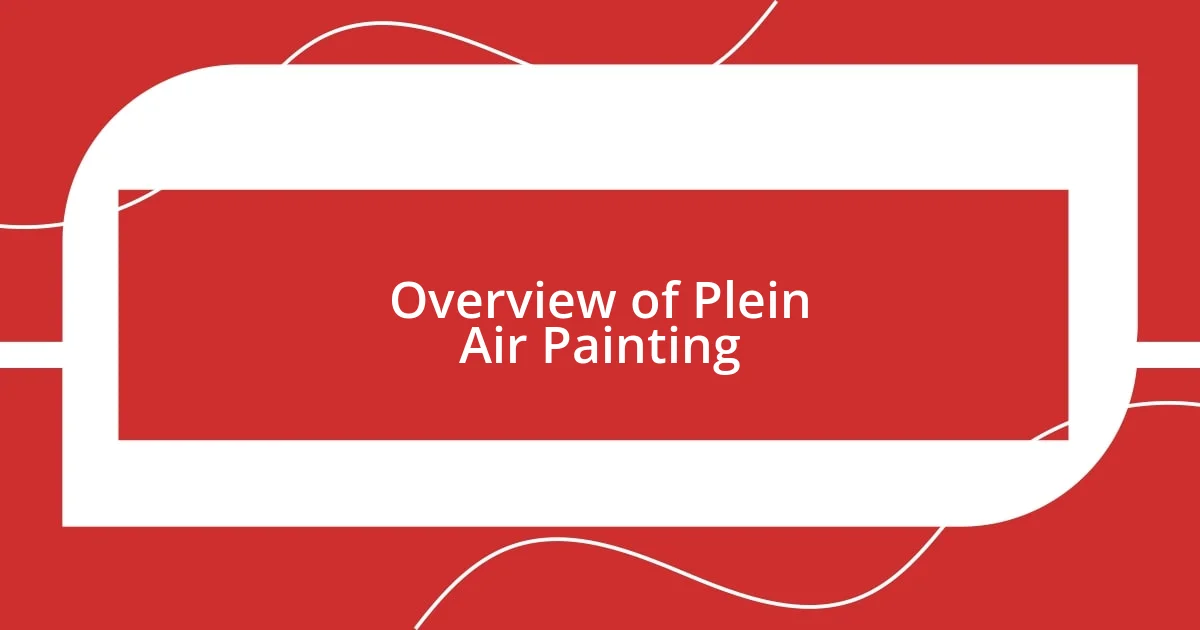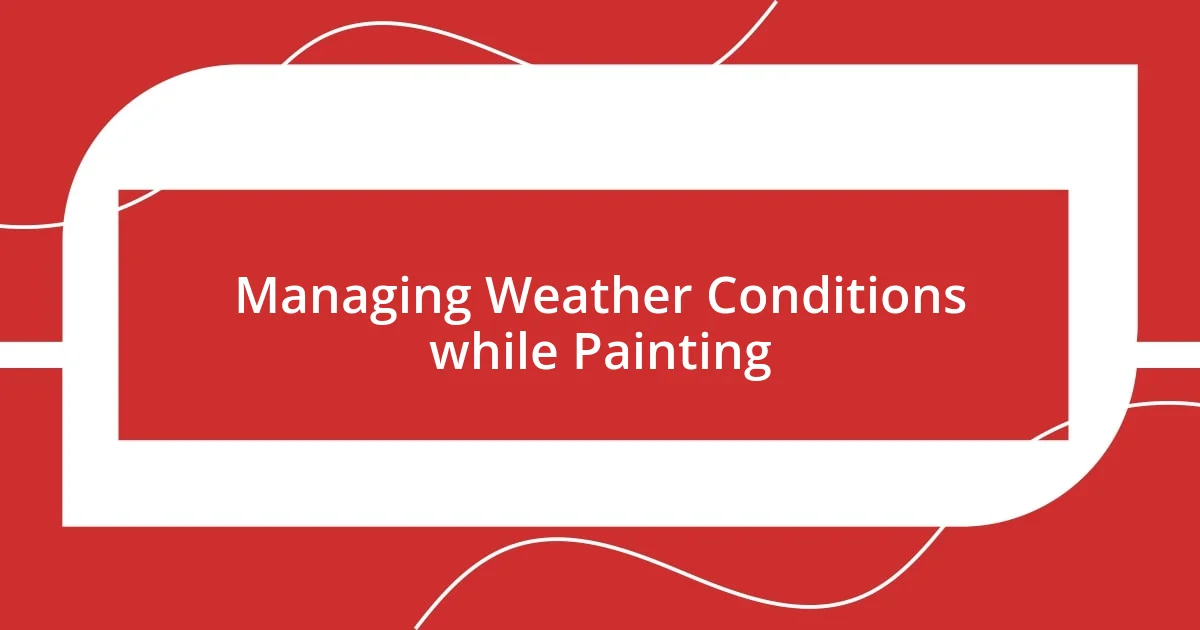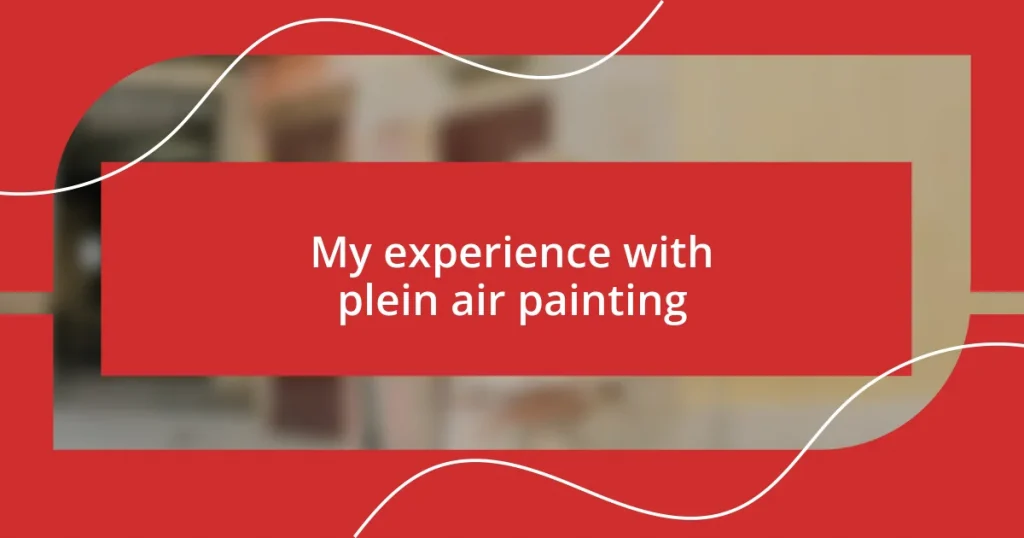Key takeaways:
- Plein air painting emphasizes capturing the essence of a scene in real time, influenced by changing light and atmosphere.
- Managing weather conditions is crucial; artists should be prepared and flexible to adapt their focus based on environmental changes.
- Finding inspiring locations to paint often involves exploration and can lead to unexpected sources of creativity and beauty in everyday life.

Overview of Plein Air Painting
Plein air painting, at its core, is about capturing the essence of a scene directly from life. I vividly remember my first experience stepping outside with my canvas and brushes, feeling a mixture of excitement and trepidation as I faced nature’s raw beauty. Isn’t it fascinating how the changing light and shifting clouds can transform a simple landscape into a masterpiece?
This artistic approach gained popularity in the 19th century among Impressionists, who sought to convey the fleeting effects of sunlight and atmosphere. I can still see the vibrant greens and blues of that day as I struggled to mix the exact shade I was seeing, feeling an intimate connection with the world around me. Have you ever noticed how the sounds of nature inspire your creativity in unexpected ways?
What sets plein air painting apart is the immediacy it offers; artists must work quickly to capture the scene before it changes. I found myself racing against the clock, realizing that every stroke was a dance with time. Each session outdoors brings new challenges and joys, making every painting a unique reflection of both the environment and my emotions that day. Isn’t that what makes art so profoundly personal?

Managing Weather Conditions while Painting
Managing weather conditions while painting is a constant companion for any plein air artist. I remember one day when the clouds rolled in unexpectedly, transforming my sunny scene into a moody gray canvas. Rather than packing up in defeat, I found inspiration in the drama of the sky and used the impending storm to convey a sense of urgency and emotion in my work.
In my experience, it helps to stay prepared with the right tools and mindset. Here are some strategies that can make a difference:
- Layer Up: Dress in layers that allow for easy removal or addition based on changing temperatures.
- Protect Your Gear: Invest in water-resistant bags for your paints and canvas. This has saved me more than once from a sudden downpour.
- Choose the Right Spot: Whether it’s a natural overhang or a tree, find a location that offers some shelter from the elements.
- Stay Flexible: If conditions turn too harsh, I’ve learned that it’s okay to shift focus to a different element of the landscape, like the way the light hits a wet rock or the reflections in puddles.
- Be Patient with Conditions: I remind myself that some of the most compelling paintings come from the unexpected twists of nature—embracing the weather creates unique emotional depths.
Each session in the ever-changing outdoors teaches me about resilience and creativity in the face of nature’s whims.

Finding Inspiring Locations to Paint
Finding the right spot to paint is like a treasure hunt. I often find myself wandering through parks, fields, or along quiet streets, searching for that captivating scene that speaks to me. One sunny afternoon, I stumbled upon a secluded pond surrounded by weeping willows. The mirror-like water reflected the lush greenery, and I felt an immediate rush of inspiration. How often do we overlook these hidden gems in our own neighborhoods?
I’ve learned that some of the best locations for plein air painting are those that resonate personally. For instance, a small café with a bustling street view transformed my perspective on urban scenes. As I painted, I discovered the joy in capturing fleeting moments—like an elderly couple sharing a laugh or a child chasing pigeons. Isn’t it amazing how everyday life can be a canvas waiting to be explored?
Sometimes, inspiration can come from an unexpected place. On a chilly winter day, I found myself in a local greenhouse, surrounded by vibrant flowers and the warmth of the sun. The rich colors and soft petals sparked a new kind of creativity that I hadn’t anticipated. I couldn’t help but ask myself—how can we find beauty and inspiration in the most ordinary places, if we just stop and look? It’s a reminder that the world is full of potential waiting for us to capture it on canvas.















